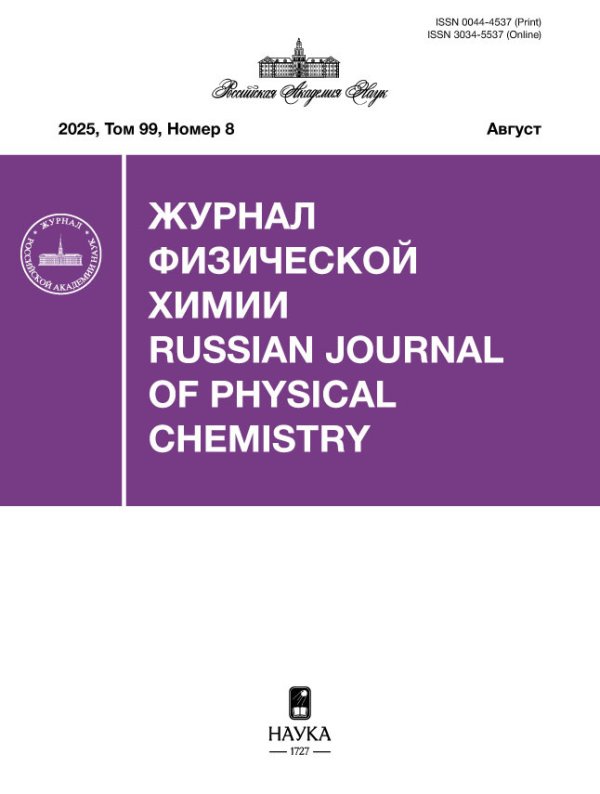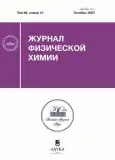Гидрофобные материалы на основе солей некоторых органических кислот
- Authors: Голубина Е.Н.1, Каменский М.Н.1
-
Affiliations:
- ФГБОУ ВО “Российский химико-технологический университет им. Д. И. Менделеева”
- Issue: Vol 98, No 10 (2024)
- Pages: 73–78
- Section: PHYSICAL CHEMISTRY OF NANOCLUSTERS, SUPRAMOLECULAR STRUCTURES, AND NANOMATERIALS
- Submitted: 29.05.2025
- Published: 11.10.2024
- URL: https://innoscience.ru/0044-4537/article/view/681102
- DOI: https://doi.org/10.31857/S0044453724100115
- EDN: https://elibrary.ru/EBBHGJ
- ID: 681102
Cite item
Abstract
Исследована смачивающая способность материала межфазных образований на основе стеаратов, олеатов, миристатов, ди-(2-этилгексил)фосфатов металлов. Показано влияние природы металла и растворителя на краевой угол материала, адгезированные на различные подложки. Установлено, что материал межфазных образований обладает регулируемой смачиваемостью. Показано, что изменяя условия синтеза можно получать однородные покрытия с величиной краевого угла поверхности изделия, модифицированной материалом межфазных образований, достигающим 145°. Проведены эксперименты по сохранению гидрофобных свойств покрытия.
Keywords
Full Text
About the authors
Е. Н. Голубина
ФГБОУ ВО “Российский химико-технологический университет им. Д. И. Менделеева”
Author for correspondence.
Email: Elena-Golubina@mail.ru
Новомосковский институт
Russian Federation, НовомосковскМ. Н. Каменский
ФГБОУ ВО “Российский химико-технологический университет им. Д. И. Менделеева”
Email: Elena-Golubina@mail.ru
Новомосковский институт
Russian Federation, НовомосковскReferences
- Ming W., Wu D., van Benthem R., de With G. // Nano Lett. 2005. V.5. № 11. Р. 2298. https://doi.org/10.1021/nl0517363.
- Larmour I.A., Saunders G.C., Bell S.E.J. // Angew. Chem. 2008. V.47. № 27. Р. 5121. https://doi.org/10.1002/anie.200705833.
- Zhu R., Liu M., Hou Y., et al. // ACS Appl. Mater. Interfaces. 2020. V.12. № 14. Р. 17004. https://doi.org/10.1021/acsami.9b22268.
- Wang R.-K., Liu H.-R., Wang F.-W. // Langmuir. 2013. V.29. № 39. Р. 11440. https://doi.org/10.1021/la401701z.
- Liao Y., Zheng G., Huang J.J., et al. // J. Membr. Sci. 2020. V. 601. № 2. Р. 117962. https://doi.org/10.1016/j.memsci.2020.117962.
- Geng Y., Li S., Hou D., et al. // Mater. Lett. 2020. V. 265. № 10. Р. 127423. https://doi.org/10.1016/j.matlet.2020.127423.
- Zhong S., Yi L., Zhang J., et al. // Chem. Eng. J. 2021. V. 265. Р. 127104. https://doi.org/10.1016/j.cej.2020.127104.
- Ou J., Zhao G., Wang F., et al.// ACS Omega. 2021.V. 6. № 11. Р. 7266. https://doi.org/10.1021/acsomega.0c04099.
- Du X.Q., Liu Y.W., Chen Y. // Appl. Phys. A. 2021. V. 127. № 8. Р. 580. https://doi.org/10.1007/s00339-21-04730-3.
- Chen Y., Liu Y.W., Xie Y., et al. // Surf. Coat. Technol. 2021. V. 423. № 10. P. 127622. https://doi.org/10.1016/j.surfcoat.2021.127622.
- Zhe Li, Xinsheng Wang, Haoyu Bai, Moyuan Cao // Polymers. 2023. V. 15. № 3. P. 543. https://doi.org/10.3390/polym15030543.
- Голубина Е.Н., Кизим Н.Ф. // Журн. Физ. химии. 2021. Т. 95. № 4. С. 508. https://doi.org/10.31857/S0044453721040075. [Golubina E.N., Kizim N.F. // Rus. J. of Phys. Chem. A. 2021. V. 95. № 4. Р. 659. https://doi.org/10.1134/S0036024421040075]
- Lee W.P., Chen H., Dryfe R., Ding Y. // Colloids and Surfaces A: Physicochemical and Engineering Aspects. 2009. V. 343. № 1–3. P. 3. https://doi.org/10.1016/j.colsurfa.2009.01.040.
- Duan H., Wang D., Kurth D.G., Mohwald H. // Angewandte Chemie International Edition. 2004. V. 43. P. 5639. https://doi.org/10.1002/anie.200460920
- Inagaki C.S., Oliveira M.M., Zarbin A.J.G. // J.of Colloid and Interface Science. 2018. V. 516. P. 498. https://doi.org/10.1016/j.jcis.2018.01.076.
- Lin Y., Skaff H., Emrick T., Russel T.P. // Science. 2003. V. 299. Р. 226. https://doi/10.1126/science.1078616.
- Reincke F., Hickey S.G., Kegel W.K., D. // Angewandte Chemie. 2004. V. 116. Р. 458. https://doi/10.1002/anie.200352339
- Кизим Н.Ф., Голубина Е.Н. // Журн. физ. химии. 2018. Т. 92. № 3. С. 457. [Kizim N.F., Golubina E.N. // Rus. J. of Phys. Chem. A. 2018. V. 92. № 3. Р. 565. https://doi.org/10.1134/S003602441803010X].
- Голубина Е.Н., Кизим Н.Ф. // Там же. 2023. Т. 97. № 1. С. 75. https://doi.org/10.31857/S0044453723010107. [Golubina E.N., Kizim N.F. // Ibid. 2023. V. 97. № 1. Р. 100. https://doi.org/10.1134/S0036024423010107.
- Kizim N.F., Golubina E.N. // Surface Review and Letters. 2023. V. 30. № 2. Р. 2350004. https://doi.org/10.1142/S0218625X2350004X.
- McDowell W.J., Perdue P.Т., Case G.N. // J. Inorg. and Nucl. Chem. 1976. 38. 2127.
Supplementary files
















